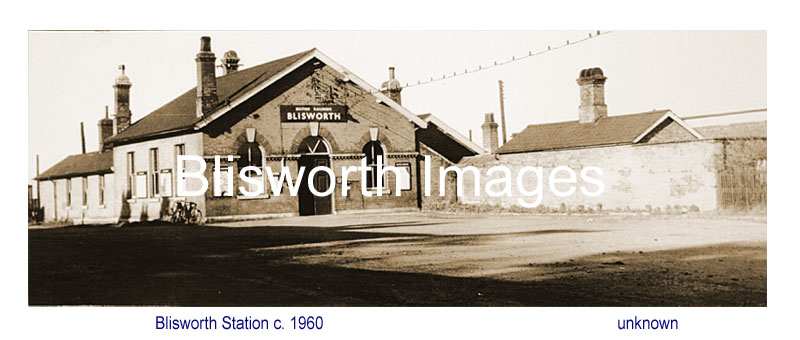|
The Railways, Part I , Blisworth, Northamptonshire, UK. All pictures are presented at relatively low resolution. There will be hundreds of pictures on this site - there is an economic limit to the webspace available. The point of this presentation is that you can see for yourself the extent of the collection and return later as the collection expands - as it surely will. Any interest in copies of a picture at a higher resolution (ie. clarity) should be directed through contacts given in the Blisworth "Round and About" parish council publication or using the comment form on the home page. In some cases the pictures are not available due to copyright restrictions. However, permission has been obtained, where possible, to include them here. Printed below each image is the photographer's name, if known. |
||
|
Back to INDEX page This is Part I Part II Part III Part IV |
||
|
There is a website dedicated to the History of Towcester Railways |
||
|
||
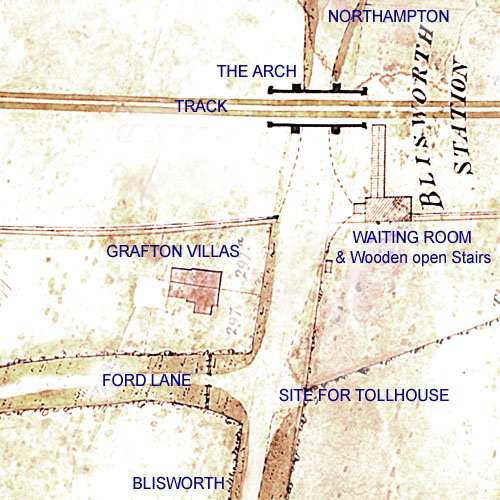 |
In the Grafton survey of 1838/9 Stephenson's rail tracks, Dunkley's arch and a rudimentary first station are shown, as are the Grafton Villas which were built to advertise stone from the Duke's quarry at Blisworth. It is believed that these villas were built c.1840. The tenant at one of the villas was the railway station master, John Thomas - the other was empty. The turnpike toll-house which is shown in a drawing in the Railway Arch section was not built until 1845-55. Northampton people were much displeased with the 1830's crude station and lobbied for a better one a half mile to the west, built 1839. A solicitor for the Duke of Grafton injected the suggestion to the railway company that, as a shortage of funds was the problem, the Duke would provide the land for the new station and pay for its approach road and a new bridge over the canal - as long as the new station was to be a 'first class' one (ie. all trains would stop there). He could see the potential benefit to the region, much of which was within his estate. |
|
|
This ended the discussions and Ford Lane then became Station Road
(see below for detail on Station Road).
Originally
it crossed the canal and joined up with other field tracks to the south,
on the slopes
of Gayton Hill. Opposite the new station was built Blisworth
Hotel by Thomas Shaw, the proprietor of the Angel Hotel in town - a successful
bid to cash in on the beginnings of a leisure industry based on the
railways as well as a base for coaches not only to and from Northampton
town but also running out across
the eastern counties. It wasn't until 1845 that a branch line to the town and on
to Peterborough was provided and until 1866 that a single track line was
completed to Banbury. Both connections were perceived very early
on to be important and it is surprising that the Banbury line (see
footnote below) took so
long to be established. 27-02 below The new station and buildings pictured at around the time of its closure in Jan 1960. The closure ceremony was given a commentary by local historian George Freeston, download the audio mp3 file here (6.70MB) |
||
|
|
||
|
Details of railway history and railway engineering
have been provided or extended Andrew has also provided this magnificent large scale map of Blisworth Station |
||
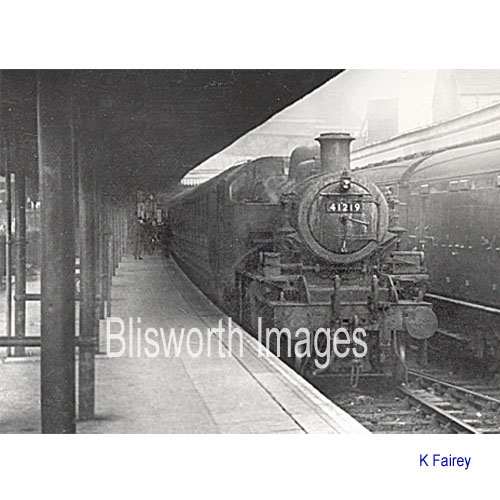 |
27-03 This is one of the locomotives which operated on the Northampton to Blisworth branch line. On a "grey and cold evening to witness a sad event for all Blisworth", as George Freeston described it, 41219 pulled into Blisworth Station for the last time at 5.35pm on January 2nd, 1960. The loco is pictured here at Northampton Castle Station a few days before its last trip on the branch line the closure of which was decided on the 10th Dec 1959 as shown by this British Rail internal letter (furnished by Andy Newbury). |
|
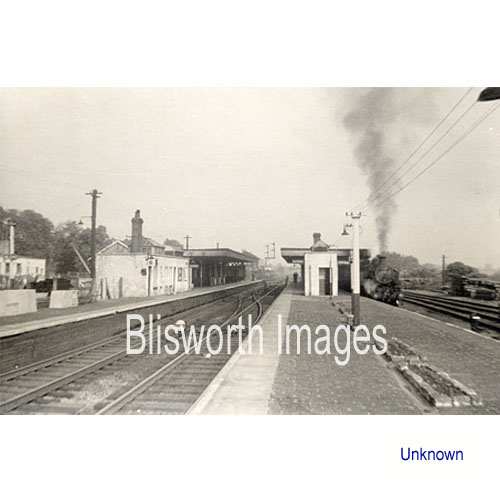 |
27-04 Blisworth Station in 1955. This may be loco 41219 or 41218. They were known as the twins and were built in Crewe in 1948. They were both mainly engaged in working the "Blisworth Motor" 3rd class coaches up and down the Blisworth branch. The purpose of the crossover in the centre of the view is explained in an article by John Whitehead. |
|
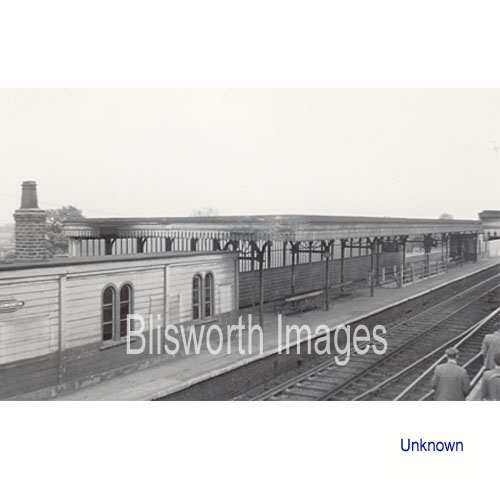 |
27-05 Blisworth Station at the time of a Stephenson Locomotive Society outing in 1960 after station closure in Jan 1960. Note the entrance to the subway, to the right, along the centre platform. | |
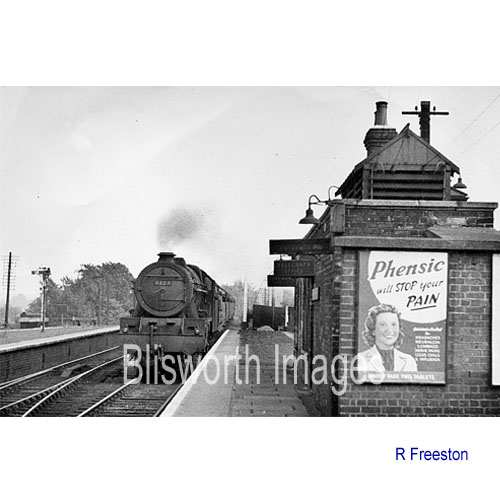 |
27-06 Dated pre-1947 - the Liverpool Express passing through the station. The loco is the "Royal Scot" class no. 6125 "3rd Carabinier" - probably traveling at 80 mph - disconcertingly close because of the narrow platforms. | |
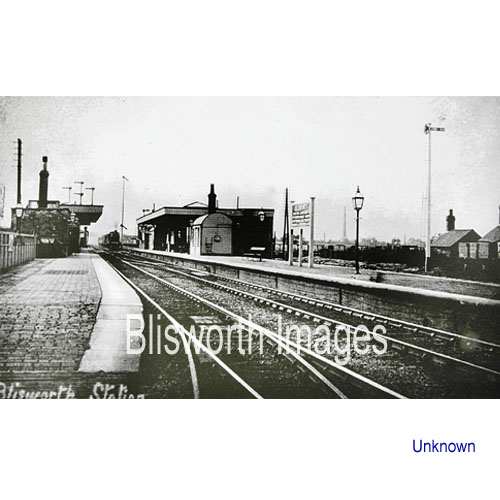 |
27-07 Blisworth Station, date probably pre-1923. Note the gas lighting and the L.N.W.R. style sign board. | |
|
Footnote: Rail accidents in this sector have been rare. There is on record a story of a death caused by flying glass as an object was smashed between two passing trains just outside the station in 1922. |
||
 |
27-07a A similar shot, looking towards London with the track to Northampton going off to the left. | |
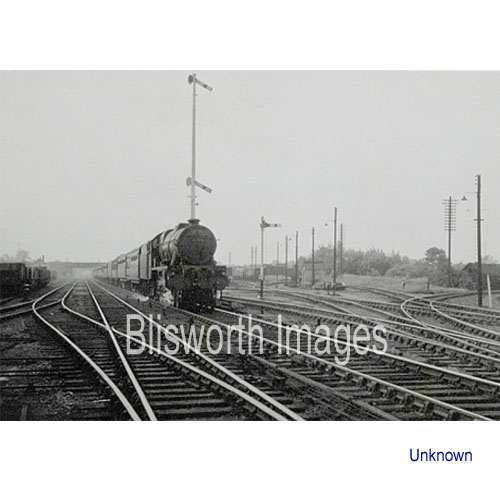 |
27-08 The Liverpool
Express drawn by the "London Scottish". The date is
post-WWII - note the L.N.W.R. style high lower quadrant signals.
The picture is taken looking "down" the line towards
Birmingham.
There are 'loops' tracks to the left explained in an article by John Whitehead. |
|
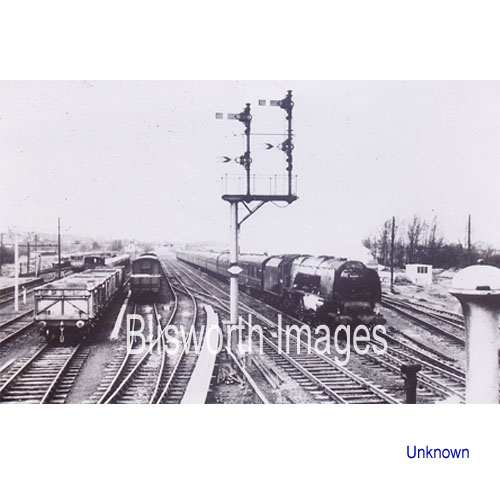 |
27-08a A later picture than the previous one - but similar location, date c. 1960. The "Royal Scot" was the most famous train on the line, running in both directions between London Euston and Glasgow Central, both trains departing at 10am and arriving at 5.15pm. The loco is the typically immaculate "Duchess" class loco no. 46245 "City of London". | |
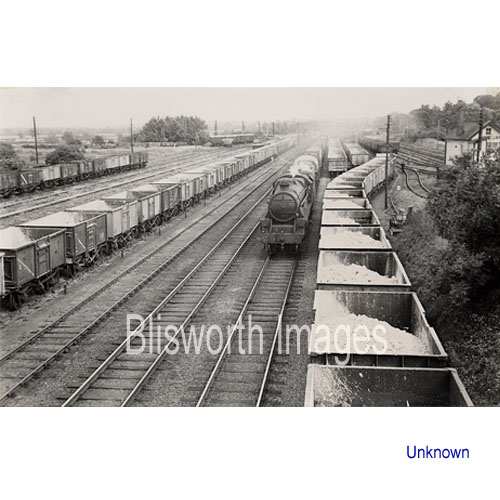 |
27-20 This picture emphasizes the extent of the wagon yard at Blisworth Station - taken from the main railway bridge. The track on the right is the Gayton Loop. | |
|
Footnote: The SMJ was 100 on January the 1st 2009 On the 1st of January 1909 'The East & West Junction Railway', 'The Evesham, Redditch and Stratford Railway', and 'The Stratford-Upon-Avon, Towcester & Midland Junction Railway' combined forces to form The Stratford-Upon-Avon & Midland Junction Railway, the SMJ. The company ran services between Broom Junction and Stratford to the west through Towcester to Blisworth and Olney in the east. The company struggled on through 'thin and thinner' until 1922 when the process began of the takeover of the SMJ by the LMS. Over its short existence it touched many peoples hearts. Andy Thompson http://www.smjr.info has written an article for Northamptonshire "Hindsight" recently, issue 15, and an extended version of that is available here. |
||
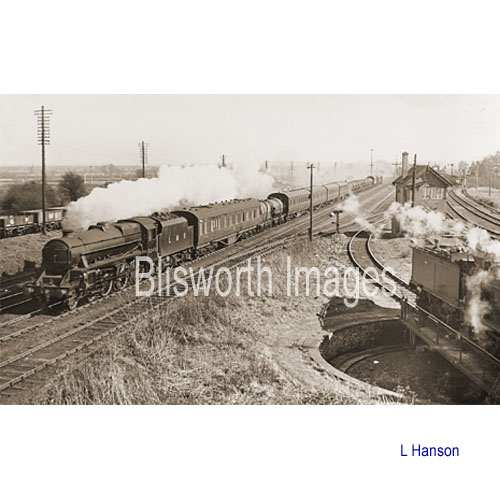 |
27-09 An interesting view taken
from between the two bridges (there were two - see 27-22) to the north of the
station. The main line is carrying what appears to be a milk-train
(comprising milk tankers and passenger coaches) under the bridge
which still stands today. There is a loco being turned in the
foreground. To the extreme right are the curved tracks which pass
under a second bridge, being the Banbury branch line. The second
bridge was removed c. 1990, to accommodate a re-routed Station Road when the
bypass was constructed around the
village.
Date of picture 1937. The box is the Blisworth S.M.J. signalbox (demolished c. 1970). The loco on the turntable is a S.M.J. line "3F", being turned for its return journey to either Banbury or Stratford-on-Avon via Towcester. |
|
|
|
||
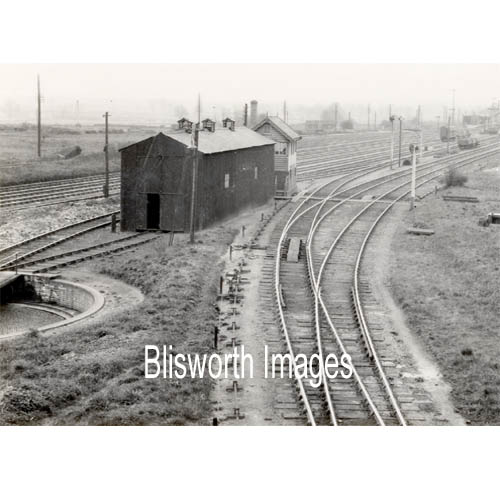 |
27-09a There was once an engine shed,
for working on SMJ engines, between the turntable and the SMJ signal
box. It was removed c. 1930 - a point which disagrees with the
following extract from loco shed website:
"To the north of Blisworth station in the fork of the Towcester and Rugby lines was located a corrugated iron 1 track straight dead-ended shed with a gable style corrugated iron roof. Facilities included a reverse turntable as the only way to gain access to the shed. On closure, the building was immediately dismantled and was re-erected as a goods shed at Towcester station. The turntable and sidings continued to be used as a stabling point at least until 1948" The turntable was installed to reverse locos using the SMJ line; not just to gain access to the shed. |
|
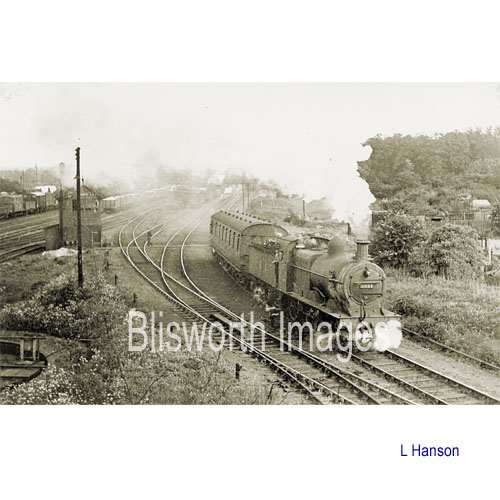 |
27-10 With the turntable just apparent to the left, this train is pulling out of Blisworth station for Banbury. Date of picture 1946 - the loco is the ex-Midlands Railway "3F" 0-6-0 type commonly used on the S.M.J. line which was often referred to as the "Slow Miserable and Jolty". Note the single coach already showing a decline in passenger numbers. A report from a 1931 tours brochure explains the need for a turntable: "on reaching Blisworth, a lengthy manoeuvre entailed shunting movements to get the train across the main line onto the SMJ railway. The engine then had to be turned on the turntable and reconnected before setting off..." Those keen on railway matters may enjoy Rolt's autobiography which includes an account of his journey by SMJ. 27-10a below - date of picture 1990. |
|
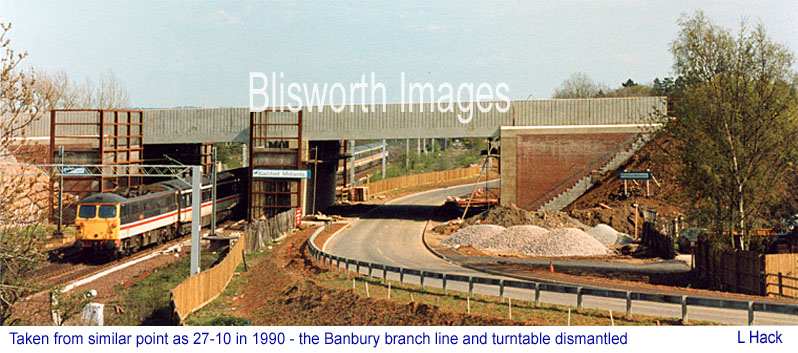 |
||
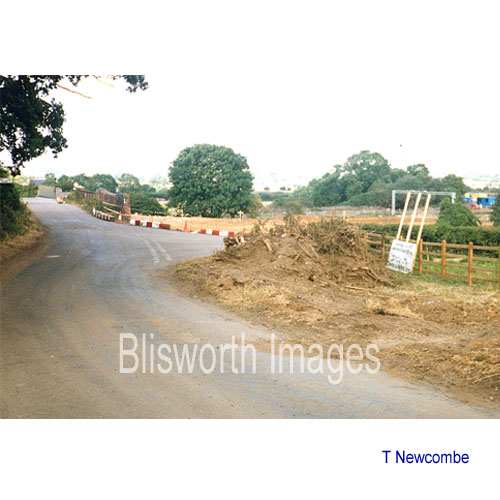 |
27-22 The picture, date 1990, shows the two railway bridges: The first in brick was over the SMJ line and was demolished to make way for the new road arrangement. The furthest, clad in steel sheeting is still there, of course, as it provides access to Blisworth Arm over the main line. | |
|
Footnote: A BTC Archive R221 dated 30th Dec 1842 refers to the 'SMJ path' in a proposal: ... but I believe a far superior communication can be made by horse rail. It is proposed that a branch horse rail from the intended new station at Blisworth, from the Loundes, running between Tiffield and Eastcote ... part of the way it would be only using one extra horse ... otherwise one horse would be able to do the whole work. The rate of travelling would be 10 miles an hour, the distance is 16 miles and the cost may be £2000 a mile. A horse at this rate would travel with two carriages with accommodation for 25 to 30 people. For goods and sheep the rate would be about 1d per ton a mile ... I am disposed to enter into communication with the London and Birmingham Directors and Mr Stephenson, their engineers with Mr Motley for the purposes of forming a company ... Yours truly Thomas Howes, Northampton. |
||
|
Footnote about Station Road: At the time Station Road was established to serve the station it was owned by the railway company and was not adopted by the N.C.C. until 1967. There was a flurry of concern as to the naming of the road once it was to be adopted (May 1967). In an insane move, the Parish Council suggested calling the part of the road nearest to Blisworth Arm by the old name of Ford Lane and the remaining part to the Grafton Villas as Station Road. The council subsequently realised the error made by the council clerk, guess who (!), in that if there were to be two names they should surely be applied the other way around. The N.C.C. lost patience at that point and decreed an end to the nonsense - the name of the entire road would stay as Station Road. The records associated with the renaming and numbering of all houses in the Parish (1952) suggest that Ford Lane and possibly also Station Road were in use (inconsistently?) before 1952 - the action then being to help the postal services and utilities companies out of their confusion. |
||
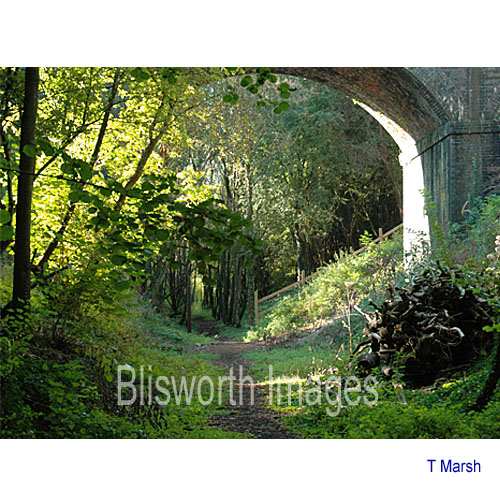 |
27-24 The SMJ line, or rather the cutting for it, has been tidied up to form a "pocket park" as it passes through Tiffield Parish. Nearer to Blisworth station, the cutting is crossed by many fallen trees. The section, which is mostly on an embankment, starting at the location of the picture above, has been used as a dog-walk until very recently (Sept 2005) - that is until the fact it is on privately owned land has been pointed out with notices. The bridge shown here carries the back road to Gayton, over the SMJ line, adjacent to where it joins the Tiffield road from Blisworth. A wooden stairs provides access from the road. In places, the cutting is very deep and a haven for rabbits. There is some local lore about the railway drivers being keen on those rabbits.
|
|
